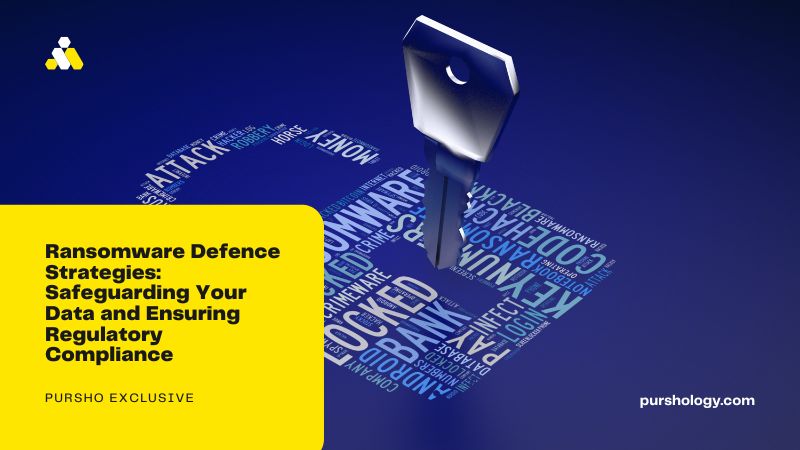Ransomware poses a significant threat in today’s digital world, where data is essential for both personal communication and business operations. It can leave you helpless, with your crucial files encrypted and held hostage by anonymous cybercriminals demanding a hefty ransom. These attacks have become a harsh reality, targeting businesses and organisations and individuals with unprecedented ferocity. However, this blog aims to guide you through the stormy seas of ransomware threats and provide you with ransomware defence strategies that emphasise vigilance, preparation, and compliance.
As technology advances, cybercriminals’ tactics also evolve. Ransomware is a type of malicious software that exploits system vulnerabilities and human behaviour. It encrypts your files, making them inaccessible until you pay a ransom, usually in cryptocurrency, to regain access. Cybercriminals use various methods to infiltrate, such as deceptive email attachments, malicious downloads, and compromised websites. Recent high-profile attacks on corporations and public institutions have highlighted the devastating effects of these assaults. Therefore, comprehending ransomware and effectively combating it has never been more critical.
Join us on this enlightening journey if you’re a business owner, an IT professional, or someone who values the sanctity of their digital world. Despite being a formidable adversary, ransomware can be defeated with knowledge, preparedness, and a commitment to compliance. Let’s explore how you can protect your data, assets, and peace of mind in an era where digital threats are rampant. With these tools, you can emerge victorious in the data security and integrity battle.
Understanding ransomware attacks
Imagine this scenario: suddenly your computer screen turns black and a threatening message appears, demanding payment in order to retrieve your valuable data. This is the work of ransomware, a type of harmful software that encrypts your files and keeps them hostage until you pay the hackers. The cybercriminals often use email phishing, malicious downloads, or compromised websites to deceive their victims. The seriousness of this threat has been emphasized by recent notable incidents, emphasizing the importance of having strong defense strategies.
Ransomware Defence Strategies
- Make sure to regularly back up your data to offline or cloud storage as an insurance policy against attacks. By having clean copies to restore from, attackers will be rendered powerless.
- Keep your digital bodyguards, such as antivirus, anti-malware, and firewalls, up-to-date as endpoint security measures. They will be able to sniff out and neutralise threats before they can infiltrate your systems.
- Empower your workforce by providing them with data security awareness training and educational sessions. Educate them on spotting suspicious emails, links, and attachments, as they are your first defence against attacks.
- Regularly update your operating systems and applications to seal potential vulnerabilities. Unpatched software is an open invitation for ransomware.
- Prevent the lateral movement of malware by segmenting your network. Implement strict access controls to limit user privileges, reducing the potential damage of an attack.
- Minimise the attack surface and reduce the potential impact of a breach by permitting only trusted applications to run and granting minimal permissions.
- Plan for the worst and hope for the best by developing a detailed incident response plan outlining steps to take in case of an attack. From containment to recovery, a well-structured plan minimises chaos and reduces downtime.
Data protection and compliance
Let’s address the obvious issue: regulations for safeguarding data. The General Data Protection Regulation (GDPR) is a significant player in this field. It requires organisations to secure personal data and promptly notify authorities of any breaches. If a ransomware attack results in a breach of personal data, GDPR obligations come into play. If customer information is compromised in an attack, you must report the breach within 72 hours. Although this may seem like a short timeframe, timely reporting indicates your dedication to adhering to regulations.
To ensure GDPR compliance during and after a ransomware attack, follow these steps:
- The first step is to determine the compromised data in order to report and assess potential risks accurately.
- Isolating affected systems is necessary to prevent further damage, followed by removing the ransomware and thoroughly cleaning the systems.
- The extent of the breach needs to be assessed to understand how much data was exposed and the potential consequences for individuals.
- If personal data is compromised and poses a risk to individuals, notify the relevant data protection authority within 72 hours.
- In case the breach poses a high risk to individuals’ rights and freedoms, it is important to inform them promptly. Maintaining transparency is crucial for preserving trust.
- A thorough post-attack analysis should be conducted to identify what went wrong and how similar incidents can be prevented in the future.
- Enlighten yourself through educational programs like GDPR training to learn on how to stay compliant with the GDPR regulation.
Incident Recovery and Compliance Reporting
Before contemplating paying the ransom during a ransomware attack, exploring all other possible solutions is important. Decrypting data is not guaranteed to be successful, and paying the ransom only supports criminal activities. It is also necessary to report the incident to relevant authorities and regulators, as timely reporting satisfies legal obligations and aids in the fight against cybercrime.
Emerging technologies and trends
The fight against ransomware is ongoing, with technology leading the charge. Machine learning (ML) and artificial intelligence (AI) are becoming increasingly advanced in detecting and mitigating ransomware threats. These technologies help security teams stay ahead of the game by analysing patterns, behaviours, and anomalies.
Blockchain technology is another powerful tool in the fight against ransomware. Its decentralised nature and cryptographic security have the potential to revolutionise data storage by eliminating single points of failure.
Cloud services also play a critical role in combating ransomware. Cloud providers often have robust security measures, and their expertise can strengthen your defences. However, it’s important to understand the shared responsibility model to avoid potential protection gaps.
It is crucial to record every action taken during and after the attack. Detailed documentation will be extremely valuable during compliance audits. It is important to keep in mind that being transparent and proactive demonstrates a commitment to safeguarding data and complying with regulations.
Conclusion
To protect your data and maintain compliance, it is crucial to have effective strategies in place against the threat of ransomware. No organisation, regardless of size, is immune to this danger. By taking a proactive approach with strong defence measures, remaining alert, and following data protection regulations, you are safeguarding your digital assets and improving the safety of the digital world as a whole. Therefore, strengthen your defences, educate your team, and let compliance serve as your beacon during the turbulent waters of cyber threats.




